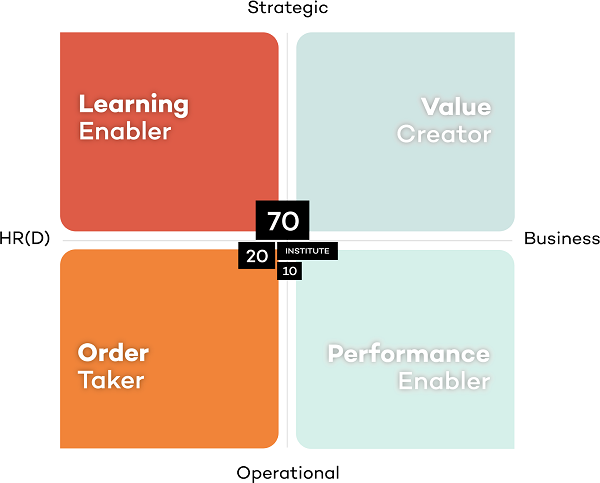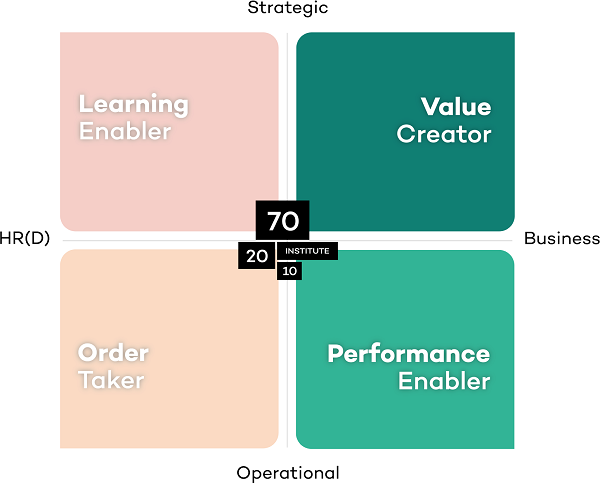ATD Blog
New Business Models for L&D
Fri Jun 01 2018

In my previous post, I discussed how L&D has been modernizing the services it provides. The 70:20:10 Institute’s new book, New Value Creators: Four Business Models That Redefine L&D With 70:20:10 (currently in press) makes a distinction between four L&D business models to redefine the future of L&D.
The first two business models—the Order Taker and the Learning Enabler—operate in the learning paradigm (see Figure 1). The other two operate in the business paradigm.
Let’s take a closer look.
Figure 1. Operating Models for L&D in the Learning Paradigm

Business Model 1: Order Taker
The Order Taker is responsible to customers in terms of providing formal learning solutions. Under the motto “If you want it, we’ve got it,” L&D departments operating on this business model ensure learning solutions are available to match client demand.
L&D departments operating on the Order Taker model also make the service provision as simple and efficient as possible. They offer no complex training analysis, theoretical models, or evaluations, but supply a detailed professional catalog of the available formal learning solutions.
The Order Taker has the budget to facilitate training in organizations and take the burden from management when it comes to learning issues. This mix of activities and services makes the Order Taker attractive to management and training participants alike, thanks also to an inherent pragmatism, decisiveness, and strong operational focus.
One disadvantage for the Order Taker is the near absence of evaluation to demonstrate business impact—justification of expenditure is based on an overview of costs and the resulting participation in online and offline learning activities. Management regards the Order Taker as a cost center.
Business Model 2: Learning Enabler
Educational advice forms the core of the service offered by the Learning Enabler. The Learning Enabler is responsible for organizing the intake, analysis, implementation, and evaluation processes required to maintain the professional quality of learning provision.
The Learning Enabler engages in dialogue with the client, using educational analysis to establish whether a formal or other learning solution is the best response to the challenge. Effective learning analysis also establishes the target group’s needs and matches the program to these needs.
In practice, the L&D departments operating as the Learning Enabler usually cannot answer requests from clients with a clear “no”—sometimes against their better judgment. The Learning Enabler also tends to be dependent on the client’s decision as to whether to go forward with the recommended learning solution.
As well as maintaining a professional learning catalog, the Learning Enabler often works within learning landscapes or a learning and performance ecosystem. In practice, the main strength of the Learning Enabler lies in the provision of professional, formal online and offline training. The focus is clearly strategic, ensuring that the learning provision reflects the organization’s overall priorities. This is the best way of reconciling learning with organization development.
The Learning Enabler tends to use the Kirkpatrick and Phillips models to express the effectiveness of solutions in terms of learning values (Kirkpatrick levels 1 to 3), business value (Kirkpatrick level 4), or return on investment (Phillips). In practice, however, it is difficult for the Learning Enabler to demonstrate business impact in more than 20 percent of the learning solutions offered. For this reason, senior management also regards the Learning Enabler as a cost center, asserts Steven Titus Smith in his LinkedIn article, “How to Save the L&D Brand from Irrelevance, Step by Radical Step.”
The last two business models, the Performance Enabler and the Value Creator, operate in the business paradigm (see Figure 2). In these models, you need learning professionals in business or performance roles.
Figure 2. Operating Models for L&D in the Business Paradigm

Business Model 3: Performance Enabler
The Performance Enabler implements the operational and other priorities of the business. The services provided focus entirely on helping teams and individuals to work better and make continuous improvements. The emphasis on business outcomes is the result of adopting a perspective on working and learning that is not purely educational.
The Performance Enabler analyzes the organization’s systems and does not regard learning solutions as the only response to business problems or opportunities. As explained in 70:20:10 Towards 100% Performance , the Performance Enabler is closely involved in the following roles within the 70:20:10 reference model: the Performance Detective, the Performance Architect (with an operational focus), and the Performance Master Builder.
The Learning Enabler is less effective in the Performance Game Changer and Performance Tracker roles than the in the Value Creator model. This is partly why they cannot always demonstrate business impact. However, senior management regards the Performance Enabler as on the way to being a revenue center.
Business Model 4: Value Creator
By expanding the service to the whole spectrum of 70-20-10 provision, the Value Creator implements management’s strategic priorities, offering more than formal learning solutions, and co-creates solutions with management and best performers to make a measurable contribution to improving organizational performance.
The Value Creator acts fully in line with the 70-20-10 model by referring not only to the five roles to utilize the model, but to the 70-20-10 methodology—the processes and approaches that enable the roles.
The five roles described in 70:20:10 Towards 100% Performance form the foundation of the methodology and, initially through the Performance Detective role, enable business alignment and value. The Performance Architect role provides the ‘100’ solutions at system level, and the Performance Master Builder role contributes to the required mix of formal learning and workplace business solutions, with formal learning no longer being the dominant solution, as it is for both the Order Taker and Learning Enabler business models.
The Performance Game Changer role within the Value Creator model is responsible for implementing business solutions, and the Performance Tracker role takes measurements based on an agreed-upon plan with management and business KPIs.
Everything the Value Creator does demonstrates measurable business impact in the form of business cases or quantified ROI. The Value Creator is a profit center for management, with income and value-add exceeding expenditure. This is also the norm for all other parts of the organization required to contribute to its profitability.
No Stereotypical Business Models
In practice, there are obviously blends of Order Taker and Learning Enabler, and of Performance Enabler and Value Creator. The Performance Enabler and Value Creator may also contain components of the Order Taker or Learning Enabler—for example, where learning solutions are developed and deployed to meet regulatory or compliance requirements, provided by the Performance Enabler and Value Creator.
These four business models have been presented to hundreds of L&D professionals across the world. Surprisingly, they enjoy a very high degree of recognition, and L&D professionals are motivated to move toward the roles of Performance Enabler and Value Creator.
No Fixed Order
The four L&D business models are not intended to be prescriptive. For example, L&D leadership may make a deliberate choice to remain within the Order Taker model for one or two years while it reviews options for change. An Order Taker may also move immediately to the right, either directly to Value Creator or indirectly via the Performance Enabler. There is no fixed path, profile, or sequence, although we do recommend that L&D moves toward the right (toward the business). This move offers opportunities to be a profit center, which is good for any part of an organization—not least L&D.
Want to learn more? Join me at the ATD 2018 International Conference & Expo for the session "New Value Creation With 4 L&D Business Models."
